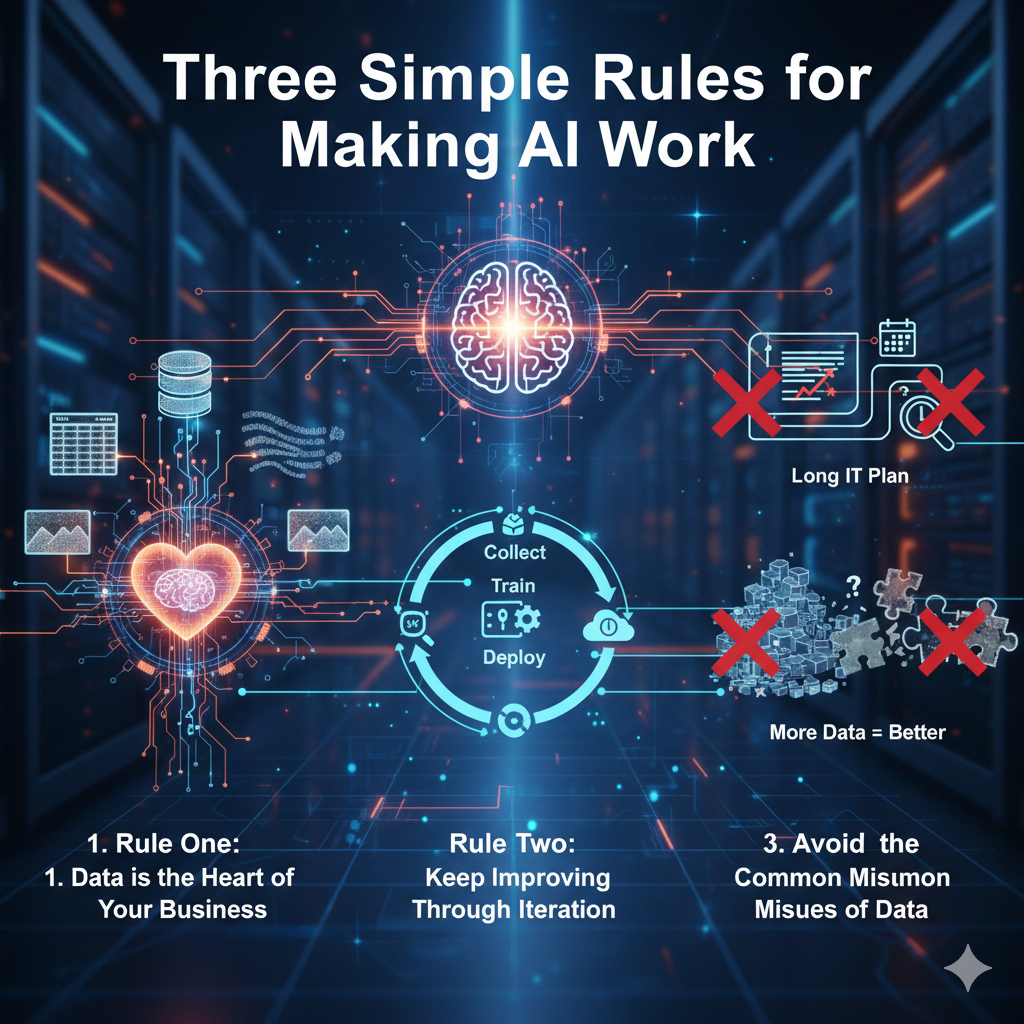Everyone agrees that data powers AI, but very few use it wisely. Data is often described as the fuel for the machine learning engine, yet it rarely arrives clean or ready to use. Real success in AI depends not only on having data but on knowing what kind of data matters, how to build around it, and how to avoid common mistakes.
Rule One: Data is the Heart of Your Business
Data is not just numbers in a file. It is a reflection of your business. You define what the inputs and outputs mean. That definition shapes how AI learns and what it can do.
| Data Set | Potential A (Input) | Potential B (Output) |
|---|---|---|
| House Size, Bedrooms, Price | (Size, Bedrooms) | Price |
| Machine Temperature, Pressure | (Temp, Pressure) | Machine Failure (Yes or No) |
| Customer Purchase History, Price Offered | (History, Price) | Product Purchase (Yes or No) |
Each of these examples shows how data directly connects to your business question. You are not just collecting numbers. You are deciding what matters.
Data also comes in two main forms. Structured data fits neatly in tables and spreadsheets, such as housing prices or temperature logs. Unstructured data includes things like images, audio, and text that humans understand easily but machines need help with. Generative AI often works best with unstructured data, while supervised learning handles both types very well.
When you think about your data, start by asking what problem you are solving. The value of data appears only when it connects to a real business case.
Rule Two: Keep Improving Through Iteration
Building an AI system is not a one-time task. It is a loop that repeats again and again. Every successful AI follows this same pattern.
First, you collect the data that contains your inputs and the matching outputs. Next, you train the model so it can learn to move from A to B. The first version usually fails. That is expected. The team must adjust, fine-tune, and try again many times.
Once the model starts performing well, it is deployed into the real world. That is where the real learning begins. For example, a speech model might work perfectly in a lab but fail to understand accents or noisy environments once it is in use. A self-driving car might misread new vehicle types like golf carts.
Every time this happens, the data from those failures becomes valuable. It flows back to the AI team, who retrain and improve the model. This constant cycle of feedback, learning, and updating is what makes AI systems smarter and more reliable over time.
Rule Three: Avoid the Common Misuses of Data
Many organizations stumble not because they lack data, but because they misunderstand it. Here are three mistakes that leaders often make and how to avoid them.
Mistake One – The Long IT Plan
A company decides to build the perfect IT setup first and promises to collect the perfect dataset in a few years. By the time they are ready, the business needs have already changed.
The better approach is to get your AI engineers involved early. They can tell you what kind of data to record and how often. A small change, like capturing machine readings every minute instead of every ten, can make a big difference in model quality.
Mistake Two – Assuming More Data Means Better Data
Some teams believe that having terabytes of data automatically means success. In reality, most of that data may not even connect to the problem they are trying to solve.
Before collecting or buying more, talk to your AI team about what kind of data is truly useful. Quality and relevance matter much more than size.
Mistake Three – Ignoring the Quality of Data
Data is rarely perfect. It may contain wrong labels, missing values, or strange entries. If these errors go unchecked, the model will learn incorrect patterns.
A skilled AI team can clean and organize the data so that the system learns the right things. This process may not sound exciting, but it determines whether your AI succeeds or fails.
Turning Data into Real Value
True AI success does not come from hype or futuristic dreams. It comes from disciplined use of supervised learning and a smart, iterative approach to data. When you understand your business inputs and outputs, build your models step by step, and keep refining your data, you unlock real and measurable value.
AI is not about chasing magic. It is about turning A into B, one clean, well-understood dataset at a time.



Leave a Reply